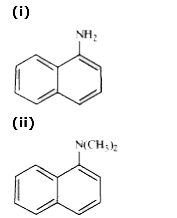Complete Solutions to Exercise of chapter AMINES of Class 12 book with complete answers and questions
| Class 12 | CHEMISTRY |
| Chapter | AMINES |
| NCERT | Exercise |
| Number Of Questions | 23 |
| Academic Year | 2023-24 |
Classify the following amines as primary, secondary or tertiary:

(iiii) `(C_(2)H_(5))_(2)CHNH_(2)" "(iv)(C_(2)H_(5))_(2)NH`
View Solution(i) Write structures of different isomeric amines corresponding to the molecular formula, `C_(4)H_(11)N.`
ii) Write IUPAC names of all the isomers.
(iii) What type of isomerism is exhibited by different pairs of amines?
View SolutionHow will you convert
(i) Benzene into aniline (ii) Benzene into N, N-dimethylaniline
`Cl-(CH_(2))_(4)`- Cl into hexane- 1,6- diamine ?
View SolutionArrange the following in increasing order of their basic strength:
(i) `C_(2)H_(5)NH_(2),C_(6)H_(5)NH_(2),NH_(3),C_(6)H_(5)CH_(2)NH_(2)and(C_(2)H_(5))_(2)NH`
`C_(2)H_(5)NH_(2),(C_(2)H_(5))NH,(C_(2)H_(5))_(3)N,C_(6)H_(5)NH_(2)`
`CH_(3)NH_(2).(CH_(3))_(2)NH,(CH_(3))_(3)N,C_(6)H_(5)CH_(2)NH_(2^.)`
View SolutionComplete the following acid-base reactions and name the products:
`(i)CH_(3)CH_(2)CH_(2)NH_(2)to" "(ii)(C_(2)H_(5))_(3)N+HCl to`
View SolutionWrite reactions of the final alkylation product of aniline with excess of methyl iodide in the presence of sodium carbonate solution.
View SolutionWrite chemical reaction of aniline with benzoyl chloride and write the name of the product obtained.
View SolutionWrite structures of different isomers corresponding to the molecular formula, `C_(3)H_(9)N.` Write IUPAC names of the isomers which will liberate nitrogen gas on treatment with nitrous acid.
View SolutionConvert
(i) 3-Methylaniline into 3-nitrotoluene.
(ii) Aniline into 1,3,5 - tribromobenzene.
View SolutionWrite IUPAC names of the following compounds and classify them into primary, secondary and tertiary amines.
`(i)(CH_(3))_(2)CHNH_(2)" "(II)CH_(3)(CH_(2))_(2)NH_(2)" "CH_(3)NHCH(CH_(3))_(2)`
`(iv)(CH_(3))_(3)CNH_(2)" "(v)C_(6)H_(5)NHCH_(3)" "(vi)(CH_(3)CH_(2))_(2)NCH_(3)`
`(vii) m-Brc_(6)H_(4)NH_(2)`
View SolutionGive one chemical test to distinguish between the following pairs of compounds .
i. Methylamine and dimethylamine
ii. Secondary and tertiary amines
iii. Ethylamine and aniline
iv. Aniline and benzylamine
v. Aniline and N-methylaniline
View SolutionAccount for the following:
(i) `pK_(b)` of aniline is more than that of methylamine.
(ii) Ethylamine is soluble in water whereas aniline is not.
(iii) Methylamine in water reacts with ferric chloride to precipitate hydrated feric oxide.
(iv) Although amino group is o– and p– directing in aromatic electrophilic substitution reactions, aniline on nitration gives a substantial amount of m-nitroaniline.
(v) Aniline does not undergo Friedel-Crafts reaction.
Diazonium salts of aromatic amines are more stable than those of aliphatic amines.
(vii) Gabriel phthalimide synthesis is preferred for synthesising primary amines.
View SolutionArrange the following:
(i) In decreasing order of the `pK_(b)` values:
`C_(2)H_(5)NG_(2),C_(6)H_(5)NHCH_(3),(C_(2)H_(5))_(2)NHandC_(6)H_(5)NH_(2)`
(ii) In increasing order of basic strength:
`C_(6)H_(5)NH_(2),C_(6)H_(5)N(CH_(3))_(2),(C_(2)H_(5))_(2),NH andCH_(3)NH_(2)`
(iii) In increasing order of basic strength:
(a) Aniline, p-nitroaniline and p-toluidine
(b) `C_(6)H_(5)NH_(2),C_(6)H_(5)NHCL_(3),C_(6)H_(5)CH_(2)NH_(2)`
(iv) In decreasing order of basic strength in gas phase:
`C_(2)H_(5)NH_(2),(C_(2)H_(5))_(2)NH,(C_(2)H_(5))_(3)NandNH_(3)`
(v) In increasing order of boiling point:
`C_(2)H_(5)OH,(CH_(3))_(2)NH,C_(2)H_(5)NH_(2)`
(vi) In increasing order of solubility in water:
`C_(6)H_(5)NH_(2)(C_(2)H_(5))_(2)NH,C_(2)H_(5)NH_(2^.)`
View SolutionConvert :
i. Ethanoic acid into methylamine
ii. Hexanenitrile into 1-aminopentane
iii. Methanol to ethanoic acid
iv. Ethanoic acid into propanoic acid
v. Ethanamine to Methanamine
vi. Methanamine into ethanamine
vii. Nitromethane into dimethylamine
viii. Propanoic acid into ethanoic acid .
View SolutionDescribe a method for the identification of primary , secondary and tertiary amines . Also write the chemical equations fo the reactions involed .
View SolutionWrite short notes on the following :
i. Carbylamine reaction
ii. Diazotisation
iii . Hofmann bromamide reaction
iv.Coupling reaction
v. Ammonolysis
iv. Acetylation
vii. gabriel phthalimide synthesis
View SolutionAccomplish the following conversions :
i. Nitrobenzene to benzoic acid ii. Benzone to m-bromophenol
iii. Benzoic acid to aniline iv. Aniline to 2,4,6, -tribromofluorobenzene v. Benxyl chloride to 2-phenylethanamine
iv. Chlorobenzen to p-bromoaniline
vii. Aniline to p-bromoaniline viii. Benzamide to toluene xi. Aniline to benzyl alcohol .
View SolutionGive the structures of A, B and C in the following reactions:
(i) `CH_(3)CH_(2)Ioverset(NaCH)rarrAunderset("Partial h ydrolysis")overset(OH^(-))rarrBoverset(NaOH+Br_(2))rarrC`
(ii) `C_(6)H_(5)N_(2)Cloverset(CuCN)rarrAoverset(H_(2)"O"//H^(+))rarrBunderset(Delta)overset(NH_(3))rarrC`
(iii) `CH_(3)CH_(2)Broverset(KCN)rarrAoverset(NaNO_(2)+HCl)underset(273K)rarrBunderset(Delta)overset(H_(2)"O"//H^(+))rarrC`
(iv) `C_(6)H_(5)COOHunderset(Delta)overset(NH_(3))rarrAoverset(NaOBr)rarrBoverset(C_(6)H_(5)OH)rarrC`
(v) `CH_(3)COOHoverset(NH_(3))underset(Delta)rarrAoverset(NaBr)rarrBoverset(NaNO_(2)//HCl)rarrC`
(vi) `C_(6)H_(5)NO_(2)overset(Fe//HCl)rarrAunderset(273K)overset(HNO_(2))rarrBoverset(C_(6)H_(5)OH)rarrC`
View SolutionAn aromatic compound (A) on treatment with aqueous ammonia and heating forms compound (B) which on heating with ` Br_2` and ` KOH` froms a compound (C ) of the molecular formula ` C_6 H_7 N`. Write the structures and `IUPAC` names of compounds (A) . (B) and (C ).
View SolutionComplete the following reactions:
(i) `C_(6)H_(5)NH_(2)+CHCl_(3)+alc.KOHto`
(ii) `C_(6)H_(5)N_(2)Cl+H_(3)PO_(2)+H_(2)Oto`
(iii) `C_(6)H_(5)NH_(2)+H_(2)SO_(4)(conc.)to`
(iv) `C_(6)H_(5)N_(2)Cl+C_(2)H_(5)OHto`
(v) `C_(6)H_(5)NH_(2)+Br_(2)(aq)to`
(vi) `C_(6)H_(5)NH_(2)+(CH_(3)CO)_(2)Oto`
(vii) `C_(6)H_(5)N_(2)Cloverset((1)HBF_(4))underset((ii)NaNO_(2)//Cu,Delta)rarr`
View SolutionAniline can not be prepared by Gabriel phthalimide synthesis due to-
View SolutionWrite the reaction of (i) aromatic and (ii) aliphatic promary amines with nitrous acid .
View SolutionGive explanation for each of the following :
(i) Why are amines less acidic than alcohols of comparable molecular masses ?
(ii). Why do primary amines have higher boiling points han tertiary amines ?
iii. Why are aliphatic amines stroner bases than aromatic amines ?
View Solution
Exercise questions and complete solutions for chapter AMINES of NCERT CHEMISTRY(ENGLISH) of Class 12